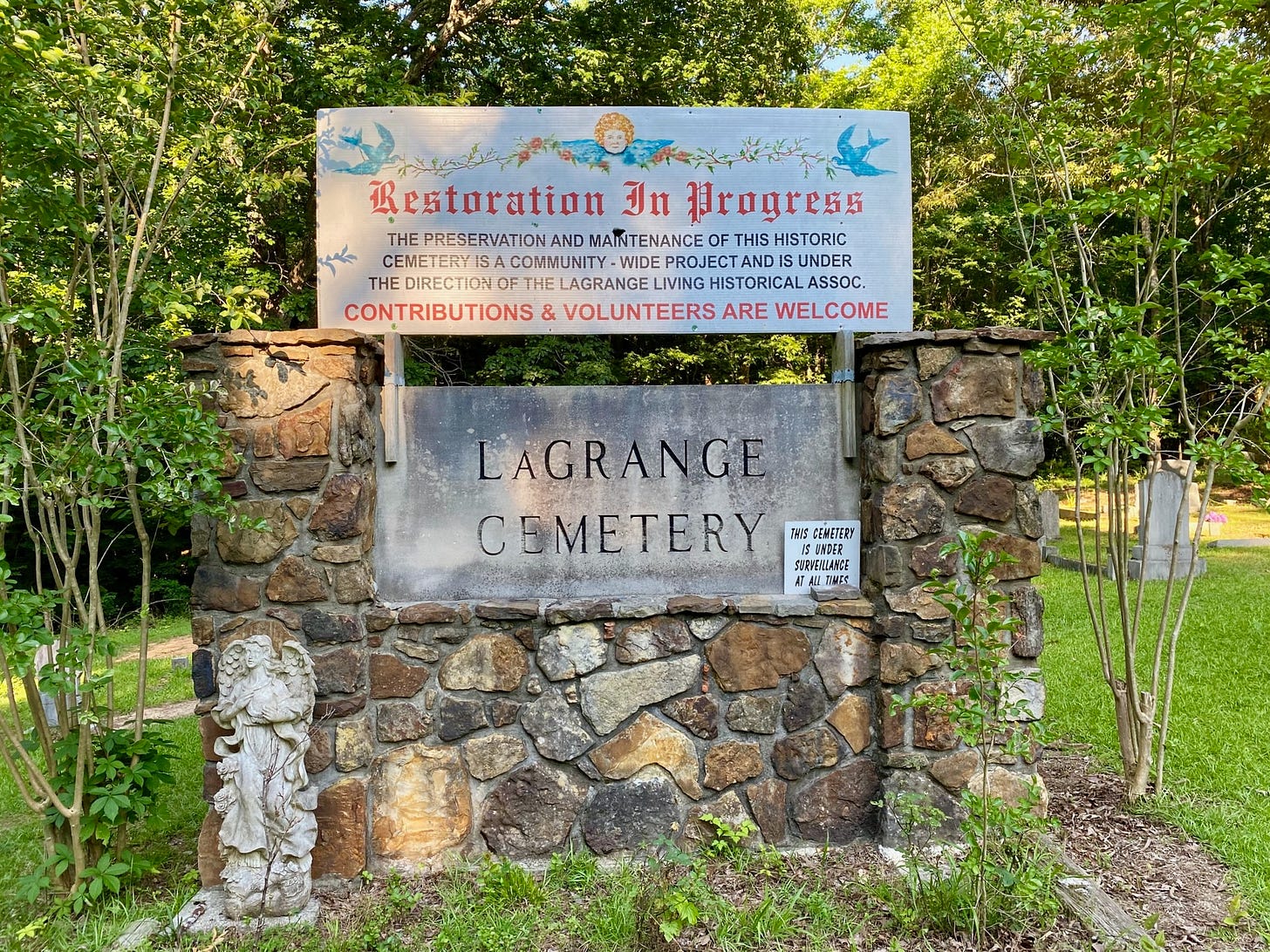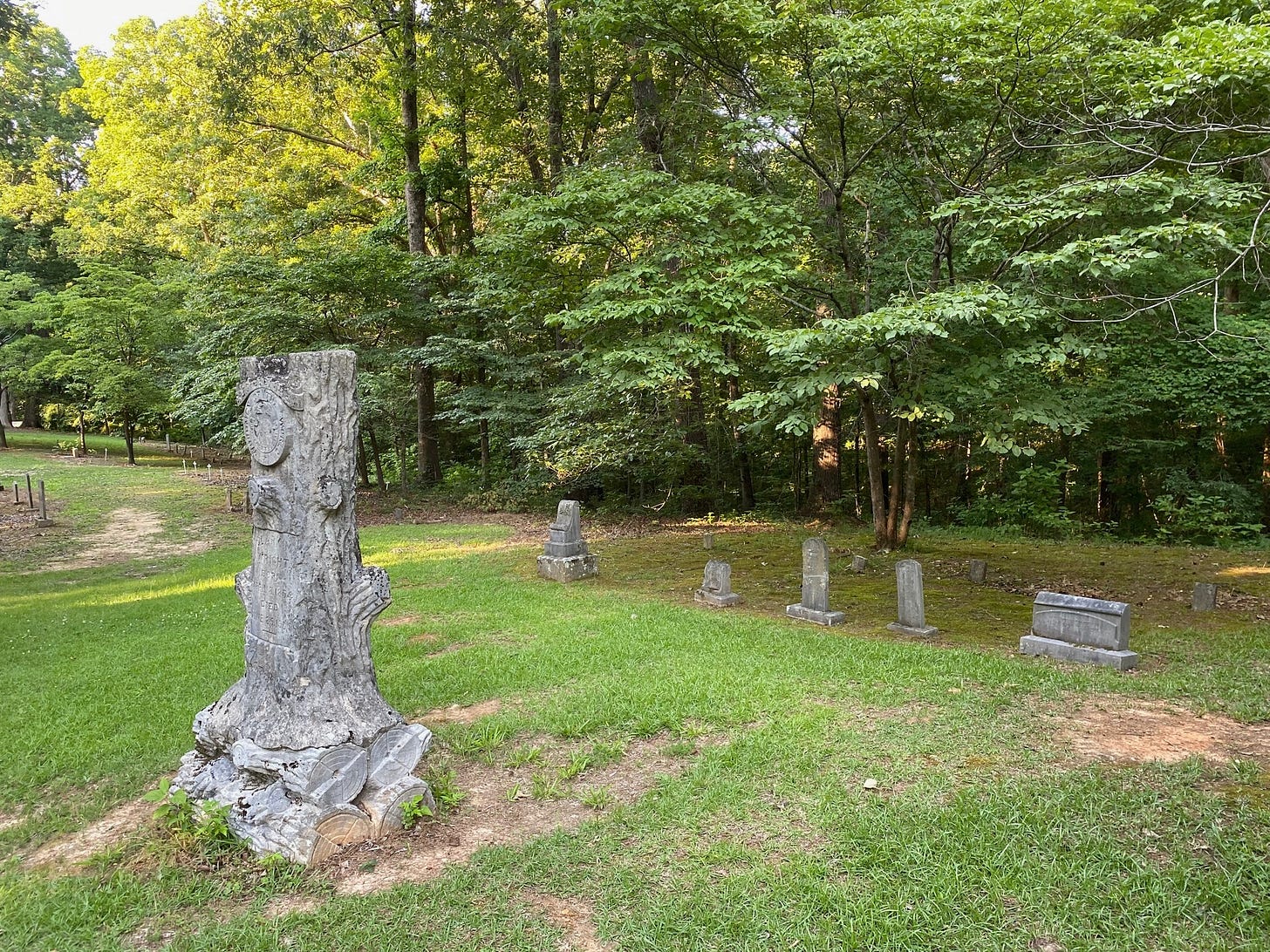Nestled in the serene landscapes of Northwest Alabama, LaGrange Cemetery stands as a silent witness to the state's rich and varied history—serving as a tranquil retreat for visitors and history enthusiasts alike. Some say the cemetery is haunted, with many ghostly tales being told over the years. On our visit, it offered more of a respite amid nature in moments of introspection.

The Hilltop Legacy
LaGrange Cemetery rests on the historic grounds of Alabama’s first chartered college, LaGrange College, established in 1830. Perched atop a hill with sweeping views of the surrounding countryside, the college once symbolized intellectual ambition in a young state. Its academic halls gave way to a military academy by the 1850s as the nation edged toward civil war. In 1855, the college moved to nearby Florence, Alabama, and would later become the University of North Alabama. The remaining campus on LaGrange Mountain was burned by Union troops in 1863 but its cemetery endures.
Today, the LaGrange College Site Park is home to a pioneer village that preserves the memory of those who once walked the grounds. Occasional re-enactment events incorporate actors portraying those buried at the cemetery, including Annie Vinson Ford, aka the Petrified Lady. Annie was “discovered petrified after being removed from her burial plot to another plot in the cemetery,” likely from the area’s abundant limestone water. She was only 19 years old when she died of pneumonia, leaving behind her husband, Willis, and an 8-month-old son. Her 1891 obituary reads “Mrs. Ford was sick about two weeks when the dark camel of death knelt at her door and buried her mortal remains in the icy cold fetters of death…” (They sure don’t write obits like they used to!) Her husband remarried the next year and had six more children with his next wife, whom he is buried next to, also at LaGrange Cemetery.

Whispers Among the Stones
Walking through LaGrange Cemetery is like stepping back in time. Among its weathered headstones, visitors can trace the lives of those who shaped the area’s history. The most elaborate grave belongs to Abraham Ricks, who died in 1852. His prominent monument—a marble obelisk—stands as a testament to the wealth and influence of the Ricks family, early settlers in the region. Ricks, who was born in North Carolina in 1791, married his first cousin, and moved to Alabama with several other families around 1820. He owned a plantation of about 10,000 acres and roughly 300 enslaved people. In addition to his plantation, he was the principal owner of the new Tuscumbia, Courtland & Decatur Railroad.

Philip Pendleton Barbour died at age 3 in 1837, his father on the faculty of LaGrange College, his namesake grandfather an Associate Justice of the U.S. Supreme Court. Robert Berry, who died in 1883, was the patriarch of a family with several members buried at LaGrange.
Corp. Thomas J. Davidson died at age 27 during the Civil War. Dr. George E. Kumpe, born in Germany, was one of the more distinguished physicians in the state when he died in 1887 at age 67.
Clemantha Virginia Long was but 10 months old when she died in 1857. And little Wallace Pennick was just 3 months old when he died on October 12, 1885. His mother, Mary J. Pennick, died 12 days later at the age of 23.
Personally, this is why I love cemeteries. They hold both the stories that have been revealed and the mysteries that they hold tight. Sometimes we can only imagine the lives these people lived, and sometimes we have some small record of their existence.

Take, for instance, Susan Sandford Reilly, who was born in North Carolina in 1800 and died in Alabama in 1837. Her obituary in The North Alabamian from Sept. 8 paints a bleak picture of the grief she endured:
“No family, within the bounds of an extensive acquaintance, has the writer known to suffer so severely by death, in the same period, as that of Mrs. Reilly. A few years since, her warm hearted, amiable, and pious husband, sunk into the grave; then her venerable and highly respected father; shortly afterwards, several sisters; then two lovely daughters, one of them leaving two sweet children. (both since dead.) and the other a blooming girl who withered away slowly from earth; and she too has gone to rejoin the society of those she so fondly loved below, whilst five of her youngest children are left, to drop the orphan's tear, and feel the orphan's fate. Mysterious Providence: wise and just, surely, but how inexplicable!”
Meanwhile, other markers bear the scars of time, their inscriptions fading, some starting to be enveloped by vegetation or simply crumbling. On our visit, we saw several old gravestones, some showcasing intricate carvings and motifs, while others were quite simple and humble. Some, simple crosses, another a stone marked “Unknown.” The cemetery is still active and has graves as recent as the 2020s.

Nature’s Embrace
In addition to its historic gravestones and monuments, LaGrange Cemetery is also known for its natural beauty. The landscape itself has been preserved, allowing visitors to experience the same serene environment that has enveloped the site for two centuries.
Towering oaks and cedars cast dappled shadows across the graves, while wildflowers, weeds, and moss weave a tapestry of life among the dead. The hilltop location offers historical intrigue but also provides a sense of peace and reflection that modern cemeteries often lack. It’s not hard to imagine students of LaGrange College pausing here to meditate on their futures, or families gathering to honor their loved ones beneath these same trees.

Visiting LaGrange Cemetery
For those wishing to visit LaGrange Cemetery, it is located just off LaGrange College Road in Leighton, Colbert County, Alabama. The cemetery is easily accessible by car, and ample parking is available near the entrance. From the parking area, a short walk leads visitors to the cemetery grounds, where they can explore the historic gravestones, monuments, and natural surroundings.
LaGrange Cemetery is more than just a resting place for those who came before us; it is a living testament to Alabama's early history and the enduring legacy of LaGrange College. The cemetery's historic significance, coupled with its tranquil setting, makes it a must-visit destination for history buffs, genealogists, and anyone interested in the rich tapestry of the American past. As you wander through the cemetery, take a moment to reflect on the lives of those who shaped this corner of Alabama, and appreciate the lasting impact of their contributions to the state's history.








